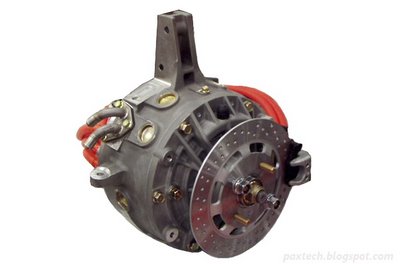- Colt EV test car uses in-wheel motors & lithium-ion batteries -

Colt EV in-wheel motor test vehicle (base model: Colt Sport-X)

In-wheel motor
Tokyo, May 11, 2005 — Mitsubishi Motors has chosen to center its development of next-generation electric vehicle technology on in-wheel motors and on lithium-ion batteries that the company has been working on for several years. Currently working on a test vehicle that utilizes these technologies, which it has dubbed the Mitsubishi In-wheel motor Electric Vehicle (MIEV) concept, the company also envisages their application to hybrid electric vehicles and fuel cell vehicles.
The in-wheel motor makes it possible to regulate drive torque and braking force independently at each wheel without the need for any transmission, drive shaft or other complex mechanical components. For this reason, MIEV offers highly promising potential in the ongoing evolution of Mitsubishi's all-wheel control technology that is employed so successfully in the Lancer Evolution, Pajero and other 4WD models. The fact that the drive system is housed inside the wheel itself offers significantly greater design freedom and also makes it easier to locate such space-consuming components as the battery system, fuel cell stacks and hydrogen tanks used in hybrid and fuel cell vehicles.
Lithium-ion battery technology offers superior specific energy, specific power, and life over other types of rechargeable batteries and as such is expected to contribute to higher top speeds, extended cruising ranges and to greater weight reductions in hybrid and fuel cell vehicles.
Mitsubishi Motors has already started development and testing of the MIEV concept using a production compact vehicle, Colt, to serve as the rolling test bed. The Colt EV uses rear in-wheel motors powered by a lithium-ion battery system. The company is also currently developing a more powerful in-wheel motor for use in a 4WD test car. The Colt EV will be on display at the "2005 Automotive Engineering Exposition" to be held at the Pacifico Yokohama Exhibition Hall, Yokohama from May 18 through May 20.
1. MIEV concept
Mitsubishi Motors was one of the first automakers to start research into and development of the electric vehicle as an alternative fuel vehicle. In recent years, the company has turned its attention to the practical application of high-performance lithium-ion battery power to propel FTO EV and Eclipse EV experimental vehicles in 24-hour distance and public road test programs.
Exploiting the benefits of lithium-ion battery and in-wheel motor technology, the MIEV concept opens up new possibilities in terms of alternative fuel vehicle development. As well as seeking further possibilities for the EV, Mitsubishi Motors is also looking at the application of the MIEV concept to hybrid and fuel cell vehicles.
(1) In-wheel motor
I. Further evolution of all-wheel control technology
A major benefit of the in-wheel motor is that it enables drive torque and braking force to be regulated with high precision on an individual wheel basis in both two- and four-wheel drive systems without requiring transmissions, drive shafts, differential gears or other complex and heavy components. The in-wheel motor therefore holds great promise in terms of the contribution to the further evolution of Mitsubishi's all-wheel control technology that enjoys high critical acclaim on such production models as the Lancer Evolution and Pajero.
II. Greater freedom in layout design
Housing the drive system in the wheels gives greater freedom in designing the layout. This will facilitate the conversion of IC engine-powered vehicles into hybrid vehicles without requiring the introduction of complex hybrid power systems. It will also make it easier to provide room for space-consuming components such as fuel cell stacks and hydrogen tanks in fuel cell vehicles. The space-saving benefits of the in-wheel motors also offer exciting possibilities in terms of body design. Designers will be able to create innovative exteriors, improve dynamic performance through weight distribution optimization, provide roomier interior space and improve crash worthiness through optimization of the structural framework.
(2) Lithium-ion battery
Lithium-ion battery technology offers advantages of specific energy, specific power, and life over other types of rechargeable batteries. Mitsubishi Motors has already built several test vehicles using lithium-ion battery systems, including the Mitsubishi HEV in 1996, the FTO-EV in 1998 and the Eclipse EV in 2000. The FTO-EV set a multiple-charge 24-hour distance world record on a proving ground, while the Eclipse EV covered over 400 km on public roads on a single battery charge. These and other testing programs have enabled the company to verify the practical applicability of this type of battery.

MIEV schematic
2. Colt EV profile
The in-wheel motor test car, Colt EV, is based on the standard compact vehicle, Colt. After removing the combustion engine, fuel tank and transmission, two in-wheel motors were fitted to the rear wheels and powered by a floor-mounted lithium-ion battery system.
Rigorous proving ground tests are now being conducted on the Colt EV. The test car is scheduled to undergo a tuning program with independent control of drive torque and braking force for left and right wheels to improve dynamic performance. After receiving vehicle type certification, Colt EV will undergo verification testing on public roads. Mitsubishi Motors will use the on-road testing program to identify and resolve any problems unique to the in-wheel motor vehicle, including any deterioration in road holding and ride comfort due to increases in un-sprung weight, as well as reliability and durability issues in the in-wheel motor system and its peripheral components (suspension, wheels, tires).
Mitsubishi Motors is continuing its motor and battery research and development programs as it seeks to improve performance while reducing size and weight. The company is currently working on a 50kW in-wheel motor for 4WD vehicle use that will eventually feature individual drive torque and braking force control for each wheel.

Colt EV layout sketch
Colt EV specifications
Base model: Colt Sport-X (1.5-liter, 4WD)
| |||||||||||||||||||||||||||||||||||||||||||||||||||||||
-Mitsubishi Motors Corporation